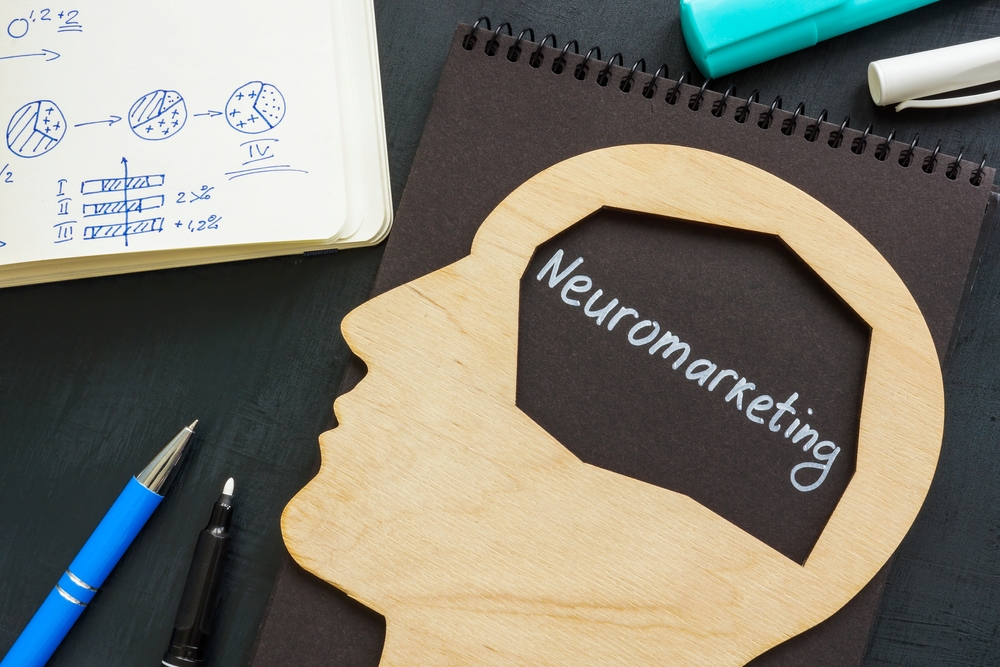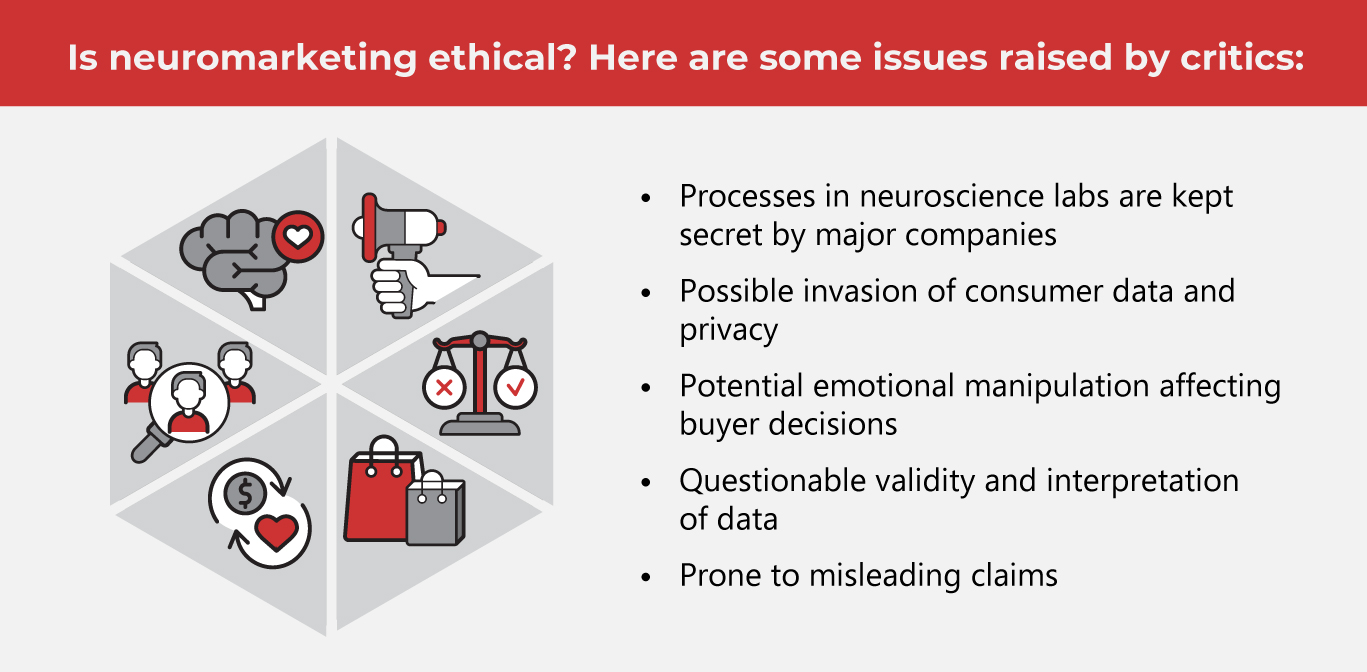Neuromarketing: How It Hopes to Boost Sales

Instead of conducting consumer surveys and focus group discussions, companies leverage neuromarketing, which uses technology to identify and predict buying behavior. We delve into this marketing strategy and learn about its developments and promising capabilities.
Reading the consumer's mind has always been a challenge for companies. What makes them stay loyal to a brand, and how do they choose what to buy? To find out, businesses have been employing fields of study like economics, social sciences, and psychology. Neuroscience has been thrown into the mix, resulting in neuromarketing, whose ultimate goal is to improve product sales.
What is neuromarketing?
Neuromarketing combines neuroscience and marketing by studying and measuring brain signals to predict and influence consumer decisions.
In the 1960s, American neurologist Paul MacLean developed the theory of the brain divided into three parts–the R complex, which quickly acts in fight-or-flight situations; the limbic system, which involves emotions; and the neocortex, which conducts analysis and reasoning.
Following this theory, neuromarketing aims to make advertisements appeal to the emotional brain, triggering the impulsive part, which conveys information to the rational component. The ultimate objective is for the target market to make the purchase.
How neuromarketing began
Marketers have always known the value of brain science in persuading consumers. A study in the National Library of Medicine states that as far back as 1896, psychologists have been probing advertising-related thought processes.
In the early 1900s, applied psychologist Walter Dill Scott maintained that consumers can be influenced by emotion, concern, and nostalgia. He also believed that advertising worked beyond giving information; it was a powerful tool for persuasion, bordering on hypnosis.
In the late 1990s, Harvard professor Gerald Zaltman suggested boosting marketing practices with brain-imaging technology. From then on, businesses became more open to experimentation, with a marketing firm establishing its neuromarketing department in Atlanta.
At first, neuromarketing research was conducted behind closed doors in partnership with prime companies like Coca-Cola, Ford and Levi Strauss. But the study flourished in the mid-2000s when researchers produced more data on how advertising and marketing strategies affected the brain.
Today, neuromarketing remains promising, especially for businesses that want to maximize promotional campaigns and develop better products.
How neuromarketing works
There are primarily two ways to conduct neuromarketing–brain monitoring and physiological tracking. These methods present marketing stimuli like ads, product packaging, and website design to the subject whose reactions are recorded.
Brain monitoring
This calculates and evaluates brain activity and is typically done with these methods:
- Electroencephalogram (EEG)
In this process, sensors are attached to the subject's scalp. Testers analyze brainwave activity–particularly the alpha and beta waves, associated with close attention. Meanwhile, theta waves indicate being in a relaxed state or disengagement.
Pros:
- Can detect changes over short intervals, providing more comprehensive data
- More affordable than other brain scanning techniques
- Safer to use than fMRI
Cons:
- Can only identify general brain activity patterns, resulting in less detailed findings
- Data interpretation requires expert analysis
- EEG signals may vary according to the subject's age, gender and brain structure
- Functional Magnetic Reasoning Imaging (fMRI)
This imaging technique uses a scanning bed with a head coil around the subject's head to capture brain images. Increased blood flow and oxygen levels in the brain indicate boosted neural activity–a positive response to the stimuli.
Pros:
- Excellent for pinpointing and measuring particular emotions
- Identifies specific images or sounds that elicited heightened neural engagement
- Can delve deep into the brain
Cons:
- Expensive to perform
- Must be conducted in a laboratory
- Subject to ethical issues because of its invasive nature
- Not as detailed as EEG
Physiological tracking
This measures and studies a person's physiological reactions to marketing material. Recorded bodily functions include skin response, heart rate, and breathing patterns. Because of its affordability, physiological tracking is more widely used. Here are some of its methods:
- Eye tracking
Testers gauge a person's attention through eye movements, fixation points and gaze patterns. They also observe the pupils, which tend to dilate when we're aroused, attracted or exposed to positive emotions.
Pros:
- Relatively cost-effective
- Easy to conduct
- Non-invasive
Cons:
- Can't evaluate emotions
- Gives limited data on cognitive processes
- Though it tracks eye movement, it doesn't provide full context on why a particular element caught the subject's attention
- Facial coding
Facial expressions are powerful communication tools used to determine the subject's emotional engagement. Through live observation and recording, small facial expressions, cues, and muscle movements are interpreted to convey happiness, disgust, surprise and other emotions.
Pros:
- Non-invasive
- Real-time analysis
- Standardized data
Cons:
- Prone to subjective interpretation
- Facial expressions depend on cultural backgrounds
- Studies a limited range of emotions
- Biometrics
Biometrics analyze an individual's unique physical and behavioral metrics. In neuromarketing, the test focuses on heart and respiration rates– and skin conductivity, which measures how intensely the skin conducts electricity, indicating emotional arousal.
Pros:
- Real-time data collection
- Quantitative information
- Can be captured in various environments, even online
Cons
- Interpretation challenges
- Data may depend on culture, individual differences, and contextual factors
- Uses equipment, special software, and expertise
Is neuromarketing effective?
Though many companies remain skeptical about neuromarketing, this field has rapidly developed in the past years. Here are some of its milestones:
2011 - Using fMRI, the University of Michigan researchers concluded that the subjects' increased brain activity while watching an anti-smoking ad predicted their probability of kicking the habit in the future.
2012 - Researchers at Emory University in Atlanta, Georgia, conducted fMRI among music listeners. Their increased brain activity correlated with the subsequent popularity of the song three years later based on its sales data.
2017 - The Advertising Research Foundation released its thorough study of neuromarketing's effectiveness, while teams from Temple University and New York University analyzed conventional marketing techniques against biometrics, fMRI and EEG. The experiments showed that though fMRI was best for giving accurate predictions, other methods can help boost ad inventiveness and efficacy.
Meanwhile, the Harvard Business Review also notes the following achievements in neuromarketing:
- A Stanford University team utilized fMRI to forecast the effectiveness and crowdfunding campaigns and online microloans more accurately than typical surveys.
- By studying the synchronicity of EGG readings of a group of people watching movie trailers, Northwestern University Professor Moran Cerf and his team achieved over 20% higher accuracy in predicting the movies' success.
Whether you're a skeptic or a believer, one thing's for sure: neuromarketing is here to stay. While its high cost keeps most businesses from adopting it, the rise of artificial intelligence (AI) and virtual reality (VR) can make neuromarketing processes faster, easier and more accurate.

 As one of the Top 19 EMS companies in the world, IMI has over 40 years of experience in providing electronics manufacturing and technology solutions.
As one of the Top 19 EMS companies in the world, IMI has over 40 years of experience in providing electronics manufacturing and technology solutions.
We are ready to support your business on a global scale.
Our proven technical expertise, worldwide reach, and vast experience in high-growth and emerging markets make us the ideal global manufacturing solutions partner.
Let's work together to build our future today.
Other Blog



